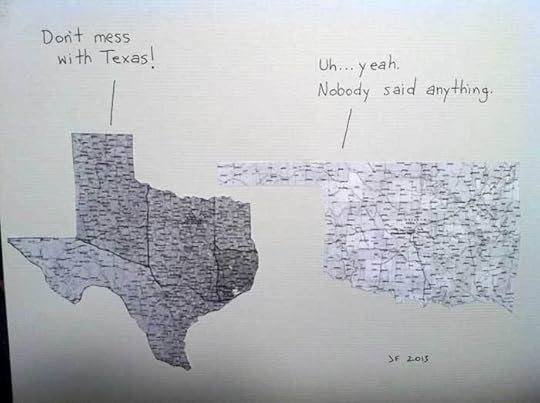Charles Martin's Blog, page 28
October 31, 2014
Dear Sue,
October 30, 2014
Slavery, Divorce, and Same-Sex Marriage: Interpreting the Bible Gayly, Part 2
In Part One, I mentioned the intransigence of fundamentalists and evangelicals in terms of how they interpret Scripture, especially in the context of same-sex marriage. The thesis of Part Two is that fundangelicals will use the Bible to oppose same-sex marriage, but their interpretive method (hermeneutic) is deeply flawed or deeply dishonest, and as I write that, it occurs to me that oblivious is an option, too.
The fundamental issue is that Christians, by and large, do not read the Bible, not in its entirety, and not to understand it. Much reading is devotional, wherein readers look for God to address them via the text. Imagine a person struggling with an issue and coming across a passage in Proverbs that says “Lean not on your own understanding, but in all your ways acknowledge Him, and He will direct your path.” That likely feels like the words are written just for their particular situation: “I’m relying too much on my own judgment. I should trust God.”
Unfortunately, “Trust God” is often a shorthand way of saying, “I won’t make a decision.” Worse, it’s an opportunity to ask someone what “God’s Word” says. This is where things can really run off the rails. Interpreting the Bible is not simply a matter of reading the text and accepting the clear meaning, partly because the meaning is not always clear, and partly because the text was written or compiled somewhere between 1600 and 4000 years ago, depending on the passage. Even if the words are clear, it is possible that the text is obscure. There is a passage in the Tanakh (the Jewish Bible, called Old Testament by Christians) about a man who must marry the woman he rapes. It’s a horrific thought for us, but in the economy of ancient Israel, a non-virginal, unmarried woman would have very limited options, like begging or prostitution, so if a rapist took her virginity (yes, I hate that phrase, too), he was financially responsible for her.
For hermeneutics, then, the context matters immensely, but that is not even the biggest problem with applying Biblical texts to contemporary issues. I feel very comfortable saying to women that they should ignore Biblical sexual ethics about virginity because the passages were written when girls married upon menstruation. Most folks can keep their virginity that long, and the issue was women as property, not sexual ethics. That much of the Bible was written for a different context, both culturally and developmentally, is clear, but fundangelicals insist that much of it still applies, including sexual ethics. Mind you, most would say that victims should not marry their rapists, nor should people own people, let alone have sex with slaves, but they are hard-pressed to let go of same-sex prohibitions. They cannot seem to recognize that interpretation is largely preferential, not exegetically consistent (the process of extracting meaning from a text). Once exegetical consistency is applied, the whole book falls apart if you insist on reading it as authoritative, but that is not a point that can be acknowledged if you wish to remain securely fundangelical.
For example, applying exegetical consistency to the issue of women in ministry yields a wide range of Biblical opinions, but fundangelicals of various tribes choose the verses they prefer to shape their church polity (church governance). The texts are in clear conflict, so only preference or appeal to a particular tradition can yield a path forward. This is not the same thing as “thus sayeth the Lord,” obviously. That all of them appeal to different and equally dubious or equally reasonable ways of understanding “God’s Word” is lost on them, because they sincerely believe they are understanding it properly (rightly dividing the word of truth, in the jargon of Scripture) while the other tribes are missing a key point.
Another example. On the issue of care for the poor, there are hundreds of verses that address care for the poor, so many in fact that it was possible for liberation theologian Gustavo Gutierrez to preach that God has a preference for the poor. The difficulty in using such texts to support government-provided welfare is related to the text’s silence about the responsibility of the government. The individual is clearly instructed to do so, as is the church, but nowhere is the care of the poor seen as a governmental responsibility. It’s possible to argue that God literally expects individuals to care for the poor, but an inference is required to say God expects the government to do the same. Alas, not all inferences are created equal.
On matters of interpretation related to the life of the individual, the fundangelical impulse has been toward a mixture of allegorical, literal, and metaphorical interpretation. When God promises Jeremiah that God knew him from the moment of his conception, the statement has often been appropriated by individuals to assert that God cares about and knows every individual intimately, and so the subsequent promise that God had a plan for Jeremiah’s life is then applied to the life of other individuals. The text nowhere says this, and so a literal promise to one person is applied via inference to all individuals. (It creeps into the abortion debate, too, as a way of buttressing arguments from “life begins at conception,” thereby attempting to use it politically.) Allegorically, Jeremiah is all of us, and so the inference is based on the most tenuous of interpretive models.
But what of verses that seem to indicate God’s law or rule about specific actions or beliefs? Those would seem to be less open to interpretation, and this is where the intransigence makes itself most obvious. The Bible nowhere addresses same-sex marriage, but it does address same-sex sex. The prohibition against same-sex sexual contact is then extended to cover same-sex marriage. As such, the extension of the principle is completely reasonable, by which I mean it is logically and exegetically consistent, even as it might be completely false. And here is the problem. It is not what the text actually says or even what it means; the issue is what believers choose to do with the text, including ignore it, as in the case of slavery, divorce, and killing people who use magic.
The intransigence is based on a willful denial of how the Bible has been handled in the past, especially in areas where it speaks clearly and forcefully about an issue. In Part One, the issue of slavery was used by way of illustration. It works here, too. Any honest reader of the Bible is forced to conclude that God either approves of or tolerates the practice of slavery. That the Mosaic law contains regulations about appropriate sex with a slave is a hideous reminder that we are dealing with a Bronze Age text, and not a book with modern sensibility woven into its words. How do fundamentalists and evangelicals deal with the question of slavery?
The most obnoxious of them insists that God is fine with slavery so long as it is not race-based. Quite frankly, this is a very, very small minority and it pains me to even call them “Christians”. Most just say that the “old law” has passed away, and in doing so, they ignore that the Apostle Paul gave instructions to slaves and masters after the “resurrection” of Jesus, and so Paul treated slavery as an acceptable practice after that “old law” had passed away. This is not terribly helpful for fundangelicals who wish to pretend that God is horrified by slavery. So horrified that God gave instructions on when and under what circumstances you could bang your slave.
It is clear that the Bible approves of slavery and condemns divorce, and it’s equally clear that fundangelicals ignore both these realities and insist that the text is consistent and authoritative even as they condemn slavery and allow for divorce. I’ve now used 1300+ words to say what is obvious; interpretation is always based on cultural contexts and tribal preference, and very, very rarely on exegetical consistency. In other words, as the culture goes, so goes the Church’s teaching on same-sex marriage…eventually.
PREVIOUS
Poot
October 29, 2014
Halloween Manimation
How has Manimation been around for a year and I am just now seeing it? Produced by Edgardo George and Lance King, this charming paper puppet series is worth your six minutes, even if your patience for Halloween has already been exhausted. Spooky Boulevard pairs casual (perhaps inebriated) story-telling with clever and meticulous puppetry. Think Drunk History, but more personal and with paper puppets instead of famous actors. George is the artist behind the recent paper cut-out replica of the Plaza District in OKC, seen below, which is his love letter to the unique retail strip dominated by locally-owned and indie-focused shops, bars, and restaurants. If you have a problem viewing the video, especially on your phone, click HERE! To see more of the series, specifically Bobbie Joe Goes to Mars and Kicked Out of Cookies, click HERE!
October 28, 2014
Hillbilly Philosopher Marfa Submission, uh, Description
The Hillbilly Philosopher is an animated short about a young
southerner, Floyd, who has spent his entire life entrenched in the
routines, misinformation and anti-progress attitudes of a fictional
town called Rodenberg, TX. At the beginning of the story, quirky and
comical (albeit sometimes crass) moments that reveal brief insight
into the lives of many of the townspeople paint the sociological
landscape of this world. Floyd’s daily drudgery in working a customer
service job at a wheelbarrow rental store, ‘Wesley-Roundabouts,’ and
the playfully dysfunctional occupation of his best friend, Butts,
teaching art to young children, show us both a funny and surreal
situation.
After visiting Butts at work to give him both a mashed potato sandwich
from his pants and a shiny, parking-lot lighter–which forces Butts to
cry uncontrollably due the overwhelming kindness of the
gesture–Floyd’s life soon changes during a stroll away from the
school and down the county railroad tracks.
Floyd temporarily stops on a tall railroad bridge to have a brief
panic attack as he notices two men kissing in the woods. He had
assumed they must hold the status of ‘best friends’ in one another’s
eyes, merely there in the meadow to romp playfully doing ‘best friend
activities;’ however, the erotic display of their inner-most fantasies
towards one another shocks Floyd’s system into what can only be
described by medical doctors as ‘hillbilly madness.’
As the madness grips his nervous system, causing discomfort similar to
that of a suppository, Floyd fails to notice the revenge-seeking
family of rabid possums and giant train plummeting down the railroad
tracks towards him in an unforgiving but efficient manner. Upon
noticing, Floyd yelps, experiences a type of ‘reverse fart’ and then
runs as fast as he can towards the safety of a nearby grassy knoll.
Many talented possums are shoved to their doom off of the sides of the
perilous tracks behind Floyd, only to ethereally emerge as vibrant
green possum angels–fluttering upward to salvation. Let us say a
prayer for them.
Upon awakening safely with his face and mouth in dirt, Floyd
notices something very existential: a teeny tiny worm. Then, he
notices something even more existential; namely, that he almost just
died. His mind becomes flooded with Kantian questions, such as: What
can I know? What should I do? What is life? What is death? And should
we put blow-up dolls in lawn chairs?
Floyd walks back into the town in which he has spent the majority of
his existence, but things seem different to him somehow. He wonders if
there is more to life than he had initially come to believe for, uh,
his whole life. Floyd goes home and sits on his couch until the sun
sets and the moon emerges, pensively contemplating. Floyd’s roommate
and former elementary school gym coach yells at him (while lifting a
barbell) for having a light on because it makes it ‘so frickin’ hot’
in the house. The coach then inquires as to why Floyd is not watching
television and therefore appearing to act like a total idiot. Floyd
attempts to explain the shift that is occurring in his own
neurochemistry, but his efforts are in vain because the coach merely
accuses him of being effeminate. Therefore, Floyd decides to visit the
trailer of Butts, Butts’ boisterous, globular wife and their 9 to 15
children.
Despite Floyd’s best explanatory efforts, Butts insists that he simply
needs a nap and supper while Butts’ wife, Diamond, is too enthralled
with television food-commercials and locating her burlap sack to even
notice that Floyd has entered their home. It is at this moment that
Floyd realizes he must go to the most terrifying place in town for
answers: the local library (spelled ‘libary’ in Rodenberg).
Due to both a rather loose and enthusiastic interpretation and
enforcement of the United States Patriot Act, Floyd’s philosophical
inquiries are observed meticulously while at the library by Big
Brother–which is simply a man in a control room who is literally
Floyd’s older brother. It is clear that Floyd must travel elsewhere to
seek both the questions and answers he is after. However, Floyd would
prefer not to ‘go it alone,’ so he propositions his best friend,
Butts, to accompany him on his journey.
Butts desires to join Floyd on this trip and Diamond is easily sold on
the idea because (1) she does not care and (2) she is obsessed with
watching a show about how nobody should be allowed to say anything in
any context during the time in which Butts is explaining the idea of
his leaving.
So, the two hillbilly philosophers begin their road trip with such
excitement that they cannot help but slap spoons against their knees,
let a kicked possum drive for a spell, repeatedly smack slabs of raw
meat against local trees and even wreck their truck into a beautiful
above-ground pool. It’s a delight!
Justin Buschardt and Jonathan Hubbell wrote and illustrated this short
film to be a pilot, with hopes that it will
one day be picked up by a network as a series. They have several
seasons of episodes written, including one in the first season solely
about Marfa–backgrounds already painted and all! Both Jonathan and
Justin love West Texas, especially Marfa. They visit the area
frequently and Justin even proposed to his girlfriend in the summer of
2014 while staying at El Cosmico as she was unsuspectingly walking to
an outdoor shower.
She said “no”, of course.
Just kidding: she said “maybe”.
Okay, fine. She said “yes”.
Anyway, the two creatives would be honored to be a part of this
festival and delighted to have yet another excuse to visit the lovely,
unique area of the world known as Marfa.
Thank you so much for your time.
October 27, 2014
Texas
October 24, 2014
Pets is FINALLY out in print just in time for Halloween ComicFest!
The long-awaited print edition arrived just in time to disseminate to some OKC shops including Dig It and New World. I will be at Empire Strikes at 600 NW 23rd St Suite 103 from 11 am-3 pm on Saturday to sign copies during the annual Halloween ComicFest going on at local comic shops across the country. Pets is my first foray in horror and is about the global liquidation of humanity through a coordinated assault by Mother Nature.
It’s a comedy.
We will be getting Pets into all of our retailers in the next week or two, but if you don’t have time to drop by a shop, feel free to pick it up at Storenvy HERE!
October 23, 2014
Interpreting the Bible Gayly, or The Holiness of Segregation
One of the most important pastoral decisions in the next year will be how a particular congregation or denomination will respond to same-sex marriage. Opponents of marriage equality have been right about exactly one thing; the granting of rights to lesbian and gay couples to marry has happened at a dizzying speed. It’s genuinely unparalleled in world history. Even if we begin at the Stonewall riots in 1969, gay marriage is now legal in the majority of the States within 45 years. Realistically, the energy behind the movement began less than twenty years ago, especially among the heterosexual population.
Only the most simplistic assessment of pop culture would locate the transitional moment in Will & Grace—no TV program has that much transformational energy—but only the willfully oblivious could miss that Will & Grace was the most palatable and popular example of a cultural shift that had already begun to change the orientation of America toward LGBT persons, and by extension, same-sex marriage.
The demographics of opposition to same-sex marriage tell the whole story at this point: fundamentalists and evangelicals (fundangelicals) tend to be opposed, as do Muslims, political conservatives, and old people. Combine three categories to find the most resistant and largest demographic: fundamentalist or evangelical political conservatives over 50. It is demonstrably true that acceptance for same-sex marriage lags in traditionalist and ethnic demographics as well, and I use ethnic, not minority, because support for same-sex marriage is very low in Latin America and Africa, not just among Hispanic Americans and African-Americans. Nonetheless, the group with the most political clout in terms of this issue remains old and really old fundangelical Christians who also happen to be politically conservative.
Those demographics matter for pastors and denominational leadership, because older, more committed members tend to be the best givers and the most reliable members in the congregation in terms of attendance and volunteerism. Only the most bizarrely fortunate minister in America has not been in a conflict with an older member of the congregation over something heard, seen, or read on conservative talk radio, cable news, or the Internet. As same-sex marriage obtains legal status in all the States—a foregone conclusion now—pastoral decisions will affect membership status particularly in respect to older and younger members.
In thinking through potential pastoral responses, it has become very clear that the American Church is facing a period of hostile reorganization, due in large part to a lack of thoughtful dialogue and theologizing based on the speed at which same-sex marriage has become the law at the same time that it has become more widely accepted. Their intransigence about hermeneutics (Biblical interpretation) on this issue has not helped either, but more on that next time. This is in part the fault of congregations and denominations who refused to believe the day would come, either because they trusted too much in the promises of fringe Right politicians or because they chose to be in willful denial about what was obviously coming. Clearly, there is another large group who believed that the Church would simply preach the message of “the Gospel” and let the consequences play out without having to reassess their view of the matrix of Scripture, Church, and Culture.
In other words, this latter group believed they could ignore how cultural shifts affect hermeneutics far more often than the interpretations shape culture. The most obvious examples are radical reconfigurations of church politics and preaching concerning slavery, and in my lifetime, the widespread cultural acceptance of divorce. For those younger than me (under 50), the idea that divorce ever caused widespread consternation in churches, except Catholic churches, is almost beyond belief, but there was a time when churches fought vigorously over the issue of what to do about divorced people, both in terms of membership and vocational ministry. In spite of Jesus’ stern words about adultery and divorce being deeply entwined, churches simply ignored Jesus and opted for a position of grace and restoration.
The pastoral response to same-sex marriage is likely to take the very same tack. Given that the demographics indicate that most opposition to same-sex marriage will be dead within 40 years, or less, churches that opt to resist the cultural shift will occupy increasingly less cultural space and will make of themselves a new species of fundamentalism. Just as any church that preached a gospel of segregation would be viewed with equal parts horror, contempt, and humor today, so too will these churches make of themselves a parody.
To borrow a Biblical metaphor, the coming storm will force pastors, congregations, and denominations to align themselves on one side or the other of this cultural shift. There will be those pastors and denominational leaders who will attempt to navigate a middle path through this, but within twenty years, that will make as much sense as a church in the current context attempting to navigate a middle path between Civil Rights and segregation. Those who opt for the middle path might just as well join the resistance, because like the churches that attempted to remain neutral during the Civil Rights struggle, they will simply be seen as the same sort of compromisers. Not taking a stand on issues of justice will always be seen as moral weakness once the dust clears, and followers of Jesus are trained to expect crucifixion, right?
October 22, 2014
My Generation: Young Chinese Artists
My Generation: Young Chinese Artists
October 25-January 18
Oklahoma City Museum of Art
415 Couch Drive
www.okcmoa.com
I saw Max Fleischer, I saw European impressionistic animation, I saw the influences of the West, but still the quiet emotion of Eastern cinema. All there in the somber animated short,21 KE, by Sun Xun. Even when flanked by a roomful of Xun’s drawings and ink-and-brush paintings in the Oklahoma City Museum of Art, there wasn’t a clear sense that “This Is Chinese Art!” Not with the same clarity of normal cultural exhibits which often consist of smatterings of traditional paintings, sculptures, perhaps some fiber art paired with period icons like headdresses, exotic weaponry, or tribal masks.
No, this was a more difficult project to put together because curators for the traveling exhibit, My Generation: Young Chinese Artists, weren’t blessed with the passage of time to naturally filter out the irrelevant, leaving a clear indication of what this era meant for the nation and the world. Instead, curators had to cherry-pick works that seemed to fit a best guess of what historians would later view as the theme for China’s rapid transformation from insular communist nation to a blossoming art scene gobbling up international influences once purged as part of the Great Proletarian Cultural Revolution. The chosen works, all created by artists born after 1976, often focus on intense industrialization, the alienation of the one-child policy, and the continuing shift away from the legacy of Mao Zedong, but still seem very familiar. Cui Ji’s architectural and somewhat abstract paintings of disjointed cityscapes could have been created by American painters in the mid-twentieth century as they awed at towers shooting up into the skies in New York and Chicago and feared how they would dwarf our humanity.
But not all of the pieces adhere closely to those ideas, such as the striking and intimidating Black Guardians installation, Song Kun’s haunting Burning Rebirth, or Birdhead’s charming photographic series. At times, it is okay to simply say, “these things are also beautiful and worth witnessing.” This lack of clarity is actually my favorite element in My Generation. The future of Chinese art is as mysterious as it is for every other sector in the amazing nation. China is still trying to get a sense of itself, a battle between the traditionalists hanging onto vague and out-dated communist ideals and the younger generation hungry for progressive energy and new ideas whether they source from within China or outside its borders. The sense of the youth dragging the olds toward the modern era is definitely familiar to left-leaning Oklahomans, but there is also the challenge of affixing meaning to an entire nation of artists, all branching in their own ways and for their own reasons now that they have finally breached the oppressive shadow of the communist regime.
Another thread that weaves between many of the works is a resilient whimsy coloring the Chinese brand of cynicism, such as Liu Di’s work where gluttonous, overgrown beasts have invaded city scenes. A giant panda looking out over the horizon as construction is dwarfed around him, a toad peering over apartment blocks. Funny, engaging, a little disturbing, the sly critique of China’s disengagement from its rural roots. A looped music video in a separate room by Double Fly Art Center shows off the more brash, punk and lollipop assault on cultural conservatism emerging in China. It is easy to draw a line between these pieces to our own youth rebellion of the twentieth century where generations battled for the soul of a nation.
So, rather than a definitive “This Is China!” My Generation is an open-ended “What Is China becoming?” The curators aren’t sure, the artists aren’t sure, and visitors won’t leave certain either, but it is clear that the young energy in that very old country is impressive, boundless, and one of the most fascinating stories to emerge in the twenty-first century.



October 17, 2014
Emmy-winning Oklahoma City rapper, Jabee, puts out debut album.
With an Emmy to his name, recognition from hip-hop pioneer Chuck D, and signed to a label owned by hip hop legend Murs, Oklahoma City’s own Jabee is considered to be among the greatest in the underground. His debut album Everything Was Beautiful And Nothing Hurt, represents what Jabee does best.
Being lyrically honest all the way throughout is the best part of this album. In every song he paints a vivid picture to the point where it’s almost like a movie without the visuals, complete with a story arch. That being said he’s not perfect. Every once in a while, he’ll rap a filler lyric such as “Fake, fake, fake, man they all fake. Hate, hate, hate, man they all hate!” He repeats this lyric twice in the song “To Whom It May Concern”, but these instances are rare.
MC’s outside of the mainstream trying to show off their lyrical skills often focus on the words, but their beats and hooks tend to suffer. That isn’t the case with Jabee because he doesn’t attempt to do his own production, but brings in help, specifically Kadence from Air Tight Productions who did almost every song. The title tack sets up the tone with a lullaby type production with really somber pianos and instruments that compliment each other. Taylor McKenzie delivers a beautiful hook which isn’t in your face like Mariah Carey, but also isn’t soft and airy.
I was surprised to see that underground powerhouse EL-P stepped in to produce “Stephanie”. The instrumentals fit the topic he’s rapping about very well. Most of the hooks were good and some of them were just instrumentals, which usually works fine.
On the album’s weakest track, “knock knock”, the hook is still a beautifully scored, influential bit of music consisting of wonderful pianos and string instruments. But the verses are completely unrelated, most of the words are just kind of the same typical lyrics you could hear anyone else spit. The beat on the verses isn’t that good either, consisting of a lot of dirty synthesizers that don’t mix well at all. It is jarring that the hook has a victory anthem feel, but the production changes out of nowhere for the verses. It just makes you wish for what could have been. The song isn’t bad on its own, it’s just not up to the same level of quality seen on the rest of EWBANH.
Overall, I think this album is amazing. Jabee is one of my favorite rappers to pick up a microphone. The sound that he raps over is really engaging with songs like “EWBANH” and “Push” which sounds like it could have been on Ghostface Killah’s TWELVE REASONS TO DIE. Every time I listen to this album, I always get the feeling that Jabee tried as hard as he could to make sure that every track was great. Is it a perfect album? No, it has its flaws, but they never get in the way of what Jabee was trying to do. Jabee’s debut album “Everything Was Beautiful And Nothing Hurt” is A worthwhile project and you can get the album for only $13 on Jabee’s website HERE.







